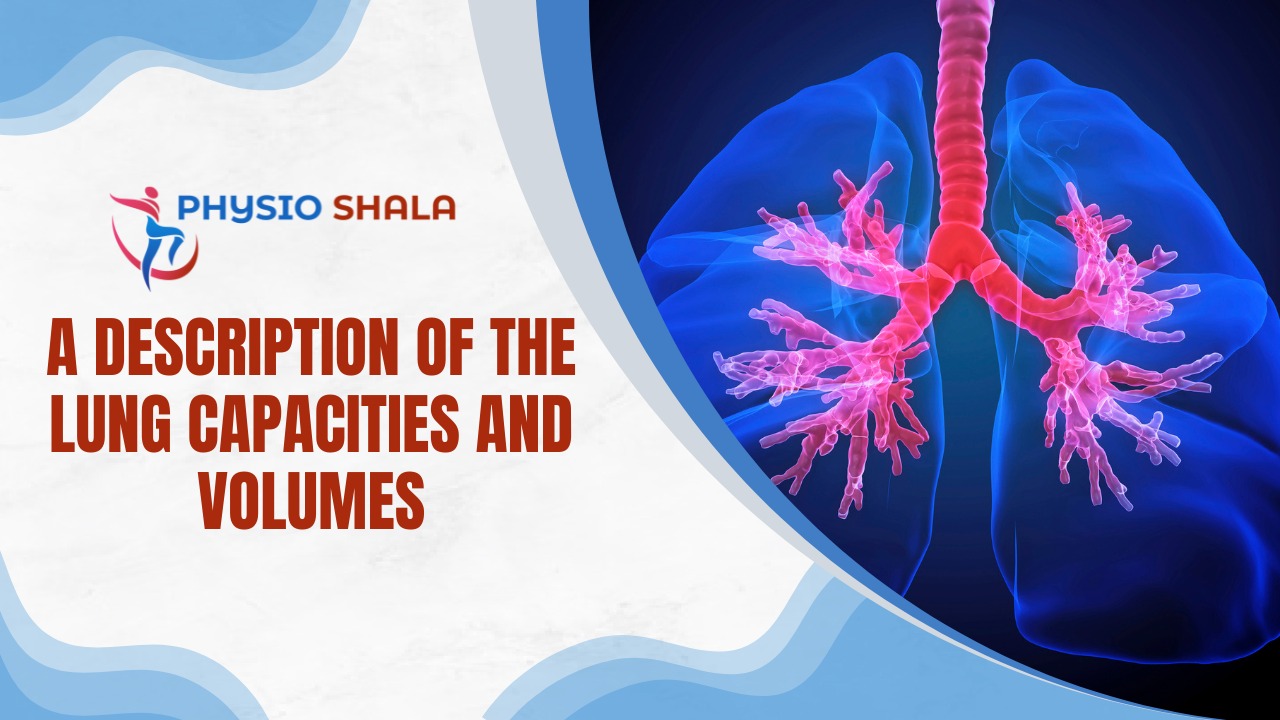Lung Volumes or respiratory volumes are the volumes of gas in the lungs at a given time during the respiratory cycle. Whereas lung capacities are obtained from the summation of different lung volumes. Measurement of lung volumes is an integral part of the pulmonary function test. The average total lung capacity of an adult is around 6 liters of air.
The lung volumes vary depending on the factors like- depth of respiration, gender, ethnicity, age, body composition, and presence of certain respiratory diseases. Spirometry, Body Plethysmography, Nitrogen washout, and Helium dilution technique are some of the tools that are used to measure lung volumes.
- Spirometer- Apparatus
- Spirogram- Record
- Spirometry- Process
Both lung volumes and capacities are of two types: Static and Dynamic. In static lung volumes and capacities, the time factor is not considered and they are expresses in mL or L; whereas dynamic lung volumes and capacities are time-dependent and hence are expressed in mL/minute or L/minute.
Static Lung Volumes and Capacities
Volumes
- TIDAL VOLUME (TV): it is the volume of air breathed in or out of the lungs during quiet respiration.
Normal value: ~500 mL - INSPIRATORY RESERVE VOLUME (IRV): It is the maximal amount of air that can be forcibly inspired after completing a normal tidal volume inspiration. IRV is usually kept in reserve but is used during deep breathing.
Normal Range: 2000-3200 mL - EXPIRATORY RESERVE VOLUME (ERV): It is the maximal amount of air that can be forcibly exhaled after the exhalation of a normal tidal volume. ERV is reduced in the cases of obesity, ascites, or after upper abdominal surgeries.
Normal Range: 750-1000 mL - RESIDUAL VOLUME (RV): it is the volume of air that remains in the lungs after a maximal expiration.
Normal Value: 1200 mL
Capacities
- INSPIRATORY CAPACITY (IC): It is the maximal volume of air that can be inspired after completing a tidal expiration.
It is computed as TV + IRV
Normal Range: 2500-3700mL - EXPIRATORY CAPACITY (EC): it is the maximal volume of air that can be expired after completing a tidal inspiration.
It is computed as TV + ERV
Normal Range: 1200-1500 mL - VITAL CAPACITY (VC): It is the maximal volume that can be expelled from the lungs by forceful effort following a maximal inspiration.
It is computed as: TV + IRV + ERV
Normal: Males- 4.8L; Females- 3.2L
Factors affecting vital capacity:
- Physiological
- physical dimension- size and body development
- Gender- VC is more in males because of large chest size, more muscle power, and more body surface area
- Age- VC reduces in old age due to loss of elasticity in the lungs
- VC is more if the respiratory muscles are strong
- Posture- VC is more in standing than in sitting or lying
- Pregnancy- VC reduces as the diaphragm is pushed up in pregnancy
- Pathological– VC reduces in the diseases of respiratory apparatus
- FUNCTIONAL RESIDUAL CAPACITY (FRC): It is the volume of air that is contained in the lungs after normal tidal expiration.
It is computed as: RV + ERV
Normal Value: 2.5 L
FRC maintains a constant residual volume which allows the continuous exchange of gases even during expiration, thereby preventing sudden changes in partial pressure of gases in the blood.
- TOTAL LUNG CAPACITY (TLC): It is the volume of air after a maximal inspiration.
It is computed as VC + RV
Normal value: 6 L
Dynamic Lung Volumes and Capacities
- TIMED VITAL CAPACITY (TVC) / FORCED VITAL CAPACITY (FVC)
FVC is the maximal volume of air that can be breathed out as forcefully and rapidly as possible after a maximal inspiration. Thus, TVC is similar to VC except that there is special stress on ‘rapid’ and ‘forcible’ exhalation.
- Components of TVC
- FEV 1 (Forced expiratory volume in 1 second)- it is the volume of FVC that is expired in the first second of exhalation.
Normal: 80% of FVC - FEV 2 (Forced expiratory volume in 2 seconds)- it is the volume of FVC that is expired in the first 2 seconds of exhalation.
Normal: 95% of FVC - FEV 3 (Forced expiratory volume in 3 seconds)- it is the volume of FVC that is expired in the first 3 seconds of exhalation.
Normal: 98-100% of FVC
-
- Clinical Significance of TVC/FVC: To distinguish between restrictive and obstructive lung disorders.
- In restrictive lung disorders, chest expansion is restricted, therefore, VC reduces while FEV 1 is normal.
- In obstructive lung disorders, inspiration is normal but expiration is obstructed, therefore, VC is normal while FEV 1 reduces.
- MINUTE VENTILATION (MV) / PULMONARY VENTILATION (PV): it is the volume of air expired or inspired by the lungs in 1 minute.
It is computed as: (TV x RR) per minute
500 x 12 = 6L/minute (during quiet respiration) - PEAK EXPIRATORY FLOW RATE (PEFR): PEFR is the maximum expiratory flow rate generated during forced vital capacity.
Normal: 400-450 L/minute - MAXIMUM BREATHING CAPACITY (MBC) / MAXIMUM VOLUNTARY VENTILATION(MVV): It is the largest volume of air that can be moved in or out of the lungs in 1 minute by maximum voluntary effort.
Normal: 90-170 L/minute (Average- 100L/minute) - PULMONARY RESERVE (PR) / BREATHING RESERVE (BR): PR is the maximum amount of air above the pulmonary ventilation, which can be breathed in and out of the lungs in 1 minute.
Computed as: {(MVV – PV) x 100}/ MVV
This is called as Dyspnoeic Index (DI)
Normal DI > 60-70% (usually 90%)
If DI is less than 60%, dyspnoea is usually present
References –
www.ncbi.nlm.nih.gov
en.wikipedia.org
www.training.seer.cancer.gov

